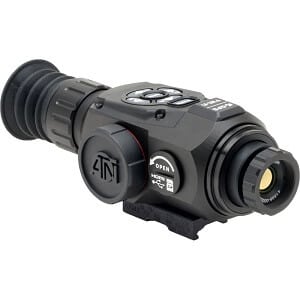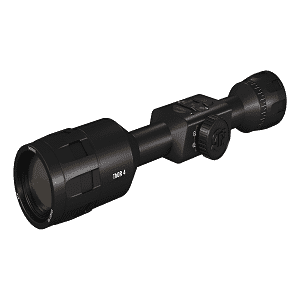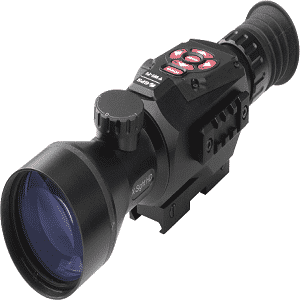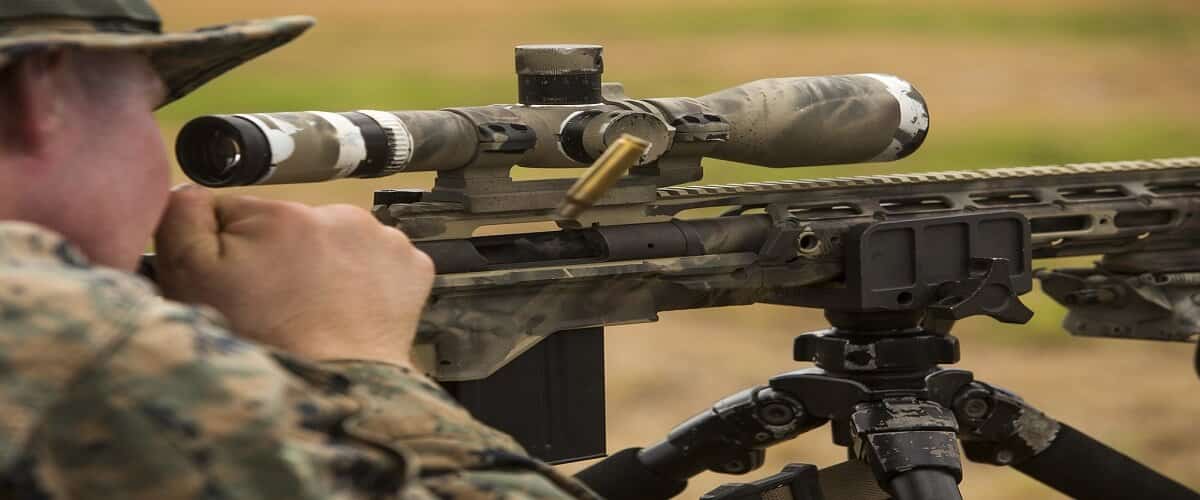Table of Contents
[As an Amazon Associate I earn from qualifying purchases. Learn more]
A hunter is as good as his gear. Knowledge and technique can only take you so far especially if you are thinking about hunting at night than you require a unique sort of item. Something that can help you find and lock on to your target easily. Something like a thermal scope. So, if you are looking to buy a thermal scope for your rifle, then this article will be perfect for you. Here, I made a list of 5 best thermal scopes for hog hunting 2022. I will also provide all kinds of information about thermal scopes, including how they work, how to choose them and much more.
So, let’s get started!
What Is A Thermal Scope?
A thermal scope is a thermographic weapon attachment that assists with vision and targeting in low light and other conditions where vision might be impaired (such as a snowstorm).

These attachments can be mounted on all types of weapons (small and large) for helping with vision at night. They work by picking up the inferred light that emits particularly from warm objects.
How Thermal Scopes Work?
As the name implies, thermal scopes work by picking up heat radiation. It has a camera that measures the amount of inferred light emitting from an object. Warm objects release more inferred light. So the camera shows warmer and brighter colors like white, yellow, red, etc.
Colder objects don’t release as much inferred light. In this case, the camera shows cool and dimmer colors like grey, black, violet and blue.
The camera has inferred sensors that pick up inferred light from different objects from your surroundings. Then the scope creates a thermogram and shows the inferred lights of different wavelengths in different colors.
This separates warm live animals from the environment as they produce more inferred light than their surroundings thus appearing brighter.
Types Of Thermal Imaging Systems
About all thermal imaging systems can separate live objects from their surroundings. But when it comes to image resolution and sensitivity, some methods are better than others. Of course, all thermal imaging systems come with their own set of advantages and disadvantages.
There are two types of thermal imaging systems:
- Un-cooled
- Cooled
Un-Cooled Thermal Imaging System:
This is your standard thermal imaging system. They use inferred detectors that work under normal temperature. You’ll find them in any normal thermal rifle scope.
Advantage:
- Inexpensive
- They don’t have any moving parts
- They are more durable
- You can be used with batteries
- They are quiet
- They activate instantly
Disadvantage:
- Not as sensitive as cooled thermal imaging systems.
- Detects changes in temperature of about 0.4 F which more than cooled systems.
Cooled Thermal Imaging System:
In this case, the imaging system has a cryogenic cooling unit. The unit cools the sensory system to a temperature below 32 F or 0℃. This makes them more sensitive to thermal changes. They are used in advanced thermal rifle scopes.
Advantage:
- More sensitive to heat radiation
- Can detect changes in temperature as low as 0.2 F
- Can be used to separate armed individuals from non-armed individuals.
Disadvantage:
- Very expensive
- They have moving parts
- They are not very durable
- Activation takes time
- They are relatively noisy
- External power source required
- They require repair or replacement within 13000 hours of use
Night Vision Vs. Thermal Vision
Both night vision and thermal vision are used for hunting game at low light conditions. Though their objectives are the same, they work very differently and have various ups and downs to them. If I had to tell you which one is better for hunting than I’m sorry to say I wouldn’t be able to. If you can afford both devices, then they both can help you in the detection and identification of your target.
Thermal vision uses inferred light emissions to detect minute differences in the temperature of different objects. This makes detecting live animals easier as they will always give off more inferred light than their environment making them stick out. This makes thermal scopes excellent for detecting live animals from great distances.
The problem with the thermal scope is that the images produced might not always be recognizable. Even though thermal scopes are great at scoping out live objects from far away, it is tough to distinguish what you’re looking at. Sometimes the targets look like glowing blobs, and it becomes hard to tell if you’re looking at a deer or a human.
Night vision
Night vision uses a different method for low light visibility. It pulls in the tiniest ambient light bouncing off objects and then amplifies it to allow vision. The sources of these lights include the moon, stars, etc. In the absence of natural light, IR illuminators can be used. They work like a flashlight for night vision scopes, but this light isn’t visible by the naked eye. Night vision devices produce structurally more accurate images making object recognition much more comfortable.
The downside of night vision is its range. It can’t be used to pinpoint targets from a distance as well as thermal imaging devices. Also, obstructions such as foliage make identifying targets much harder as it captures light jumping off all objects.
When it comes to hunting the best tactic is to use them both. A useful technique would be to use a night vision scope along with a thermal monocular or binocular. The thermal device can be used to detect animals from afar and hidden in the foliage. Then using the night vision scope attached to your rifle, you can identify whether or not it is your preferred target and take the shot.
But these are costly hardware. So I understand that everyone can’t afford both. If that’s the case for you, then my advice would be to go for a thermal scope. Yes, night vision scopes are better at identifying targets. But thermal scopes will be more useful in actually finding targets. And a lot of the times targets are recognizable enough for taking a confident shot.
How To Choose The Best Thermal Scope For Hunting?
Thermal imaging rifle scopes are quite expensive. So you should know what you’re looking for before investing in one. I want to remind you that buying the best and most costly tech isn’t going to be worth it if you don’t need that extra juice. So it’s best first to understand what you need to buy a satisfying product.
Things that you should consider before buying a thermal scope:
Your preferred game: Small game does not need scopes with high magnification. So if you are going to use the scope for hunting animals like rabbits, then buying a scope with more than 10X would be a waste of money. Smaller animals move faster. So keeping track of them with a magnification higher than 10x would be a nightmare due to decreased field of view.
Weapon size: Magnification of the scope should be directly proportional to the size of the gun or its calibre. A smaller, less powerful gun should have smaller scopes. More massive long-ranged weapons should be paired with a larger scope with more magnification.
Your distance from your target: A clear idea of how far your usual target would be. It will be hard to identify an animal any further than 300 yards with a thermal scope alone. So consider that before buying a thermal scope.
Weight of the scope: You ever had to walk a mile to get to your hunting spot you’d know how hard it is to carry around heavy gear. A lighter scope will be more natural to carry around. On the other hand, a vast scope will probably have better build quality and more features.
Resolution and refresh rate: Scopes use a camera to show you thermographic images. The higher the resolution and refresh rate of the camera, the sharper and smoother your video output will be. Also, a higher resolution will result in a better digital zoom without blurring out images. A refresh rate of 30 Hz to 60 Hz is preferred.
Top 5 Best Thermal Scopes For Hunting
Choosing a scope for nighttime hunting can be a daunting task. The market is just full of choices. So it’s pretty understandable if you find yourself confused. Based on my years of experience, I’ve made a list of only five best thermal scopes for hunting, so you don’t have to waste time scouring the internet.
You can choose any one of them based on your budget and preference and be satisfied with your purchase.
1. ATN ThOR HD 384 Smart Thermal Riflescope
 If you’re new into night hunting and looking for a thermal scope that is affordable and adequately powerful than the ATN ThOR HD 384 will be perfect for you. This is a great beginner level thermal scope that is feature-packed and doesn’t break the bank.
If you’re new into night hunting and looking for a thermal scope that is affordable and adequately powerful than the ATN ThOR HD 384 will be perfect for you. This is a great beginner level thermal scope that is feature-packed and doesn’t break the bank.
Features:
Excellent Sensor: It has a 384 x 288 sensor that is great for mid-ranged scoping. If all you’re hunting are boars, foxes and dears than this will be providing satisfactory results. The sensor is powerful enough in most scenarios, but if your target is more than 100 – 200 yards, then this wouldn’t be the ideal scope I would recommend. So if this thermal scope interests you are then going with the 1.5-5x or 2-8x variants would be perfect.
Great display: The display on the scope has a resolution of 1280 x 960 and a refresh rate of 30 Hz, which is adequate for crisp and fluid image output. This isn’t the best refresh rate out there, but it is enough to minimize blurring.
Recoil Activated video: It offers recoil activated video which eliminates your need to press the record button at the right moment. The scope will record anything seconds before you press the trigger to a few seconds after the shot is taken.
Ballistic Calculator: The built-in ballistic calculator can process all types of information such as wind speed, wind direction, humidity, altitude, etc. to assist you with taking your shot. It also has a built-in rangefinder.
Specification:
- Sensor: 384 x 288
- Display Resolution: 1280 x 960
- Refresh rate: 30 Hz
- Magnification: Comes in various magnifications (1.5-5x, 2-8x, 4.5-18x, 9-36x)
- Battery life: 8 hours (22 hours with external battery)
- Inexpensive
- Great for beginners
- Excellent sensors
- Lightweight
- Long battery life
- Recoil activated video recording
- Ballistic calculator
- Multiple reticle options
- Sharp and smooth video
- Durable build quality
- Water-Resistant
- Medium range
- Medium refresh rate
- Occasional video stuttering
2. Pulsar Core RXQ30V 1.6-6.4×22 Thermal Riflescope
 The Pulsar Core RXQ30V is also great for beginner night time hunters. This thermal scope is slightly different, having a green sapphire color output. In the beginning, this might be off-putting for some, but you’ll get used it in no time after a few days of use.
The Pulsar Core RXQ30V is also great for beginner night time hunters. This thermal scope is slightly different, having a green sapphire color output. In the beginning, this might be off-putting for some, but you’ll get used it in no time after a few days of use.
Features:
Excellent sensor: Similar to the ThOR HD 384, it also has a 384 x 288 sensor that produces unique quality videos. This scope provides sharp and clear images up to 200 yards. Of course, with further magnification objects at a greater distance can be seen, but the image quality will get a bit blurry. The magnification of this scope is 1.6 – 6.4x. So the sensor is adequately powerful for the capability of the scope.
AMOLED display: The camera has a display resolution of 640 x 480, which is less than the ATN ThOR HD 384 but has an AMOLED display that ensures brighter and more vibrant colors. The refresh rate of this scope is 50 Hz which is excellent. This allows smoother video output and almost no blurring. So the slightly less resolution is not missed in the case of the Pulsar Core.
Simpler Design: The pulsar core does not have a video recorder. This might be a significant downside for some people but for those who don’t care about the extra features and want a simple scope with great thermal imaging than the Pulsar Core RXQ30V is right for them.
Specification:
- Sensor: 384 x 288
- Display Resolution: 640 x 480
- Refresh rate: 50 Hz
- Magnification: 1.6 – 6.4x
- Battery life: 4 hours (CR123A)
- Great value
- Great for beginners
- Lightweight
- Multiple reticle patterns
- High refresh rate
- Amoled display
- Water-resistant
- Ease of use
- Great sensors
- No video recording
- Lowe display resolution
- Display color not changeable
3. ATN Thor 4, 640×480, Thermal Rifle Scope
 The ATN Thor 4 is a mid-tier thermal scope. It is an excellent choice for experienced and enthusiast hunters. Its improved sensor gives it undeniable advantages over the previously mentioned scopes. The better sensors result in ina higher range and better accuracy. This thermal rifle scope will provide the best thermal vision for the money.
The ATN Thor 4 is a mid-tier thermal scope. It is an excellent choice for experienced and enthusiast hunters. Its improved sensor gives it undeniable advantages over the previously mentioned scopes. The better sensors result in ina higher range and better accuracy. This thermal rifle scope will provide the best thermal vision for the money.
Features:
High-grade sensor: It has a 640 x 480 sensor that provides excellent thermal imaging. The high sensitivity ensures sharp thermal images from a greater distance.
Fast processor: The dual-core obsidian processor ensures rapid functionality. So there is no chance of slow processing limiting your capabilities.
Stunning display: The display is 1280 x 720 with a refresh rate of 60 Hz, which is a standard for sharp and fluid video output. This high refresh rate makes smaller targets easily visible.
Ballistic calculator: The ballistic calculator can take in information from your surroundings and assist you in aiming.
Long battery life: It can provide 16 hours of continuous operation, so you don’t have to think about conserving battery life and focus on the hunt.
Recoil Activated video: This also offer Recoil Activated Video, which makes capturing the perfect shot easy and convenient.
Specification:
- Sensor: 640 x 480
- Display Resolution: 1280 x 720
- Refresh rate: 60 Hz
- Magnification: Comes is various magnifications (1-10x, 1.5-15x, 2.5-25x, 4-40x)
- Battery life: 16 hours
- High-grade sensor
- Recoil activated video recording
- Ballistic calculator
- Multiple reticle options
- Sharp and smooth video recording and streaming
- Durable build quality
- Water-Resistant
- Dual-Core processor
- Long-range
- Expensive
- Some software bugs
- Obsidian app not very intuitive
4. Armasight by FLIR Zeus 336 3-12x50mm Thermal Imaging Rifle Scope
 The Armasight Zeus 336 is enormous thermal scope for those willing to dominate the hunting grounds. This is a mighty and versatile scope considering that it’s designed for SWAT and Military use which makes the Armasight 336 an excellent scope for serious enthusiasts.
The Armasight Zeus 336 is enormous thermal scope for those willing to dominate the hunting grounds. This is a mighty and versatile scope considering that it’s designed for SWAT and Military use which makes the Armasight 336 an excellent scope for serious enthusiasts.
Features:
Excellent sensor: The sensor is a 336 x 256 17 micron Flir technology that provides powerful thermal imaging capabilities.
AMOLED display: It has an 800 x 600 AMOLED display that ensured crisp and clear images with High contrast vivid colors. The refresh rate is 30 Hz that results in satisfyingly smooth video output.
Compact design: Its best feature is its compact design and lightweight. It is making this easy to carry around in long hunting trips. It comes with image adjustment tools that allow users to control the visuals according to their liking.
Video recording: The Armasight 336 can record videos at a high resolution so you can capture your best hunting moments.
Specifications:
- Sensor: 336 x 255 (17 microns by Flir)
- Display Resolution: 800 x 600 (Amoled)
- Refresh rate: 30 Hz (Has 60 Hz variant)
- Magnification: 2.8x (NTSC) / 3.4x (PAL)
- Battery life: 4 hours (CR123A)
- Compact design
- Lightweight
- Amoled display
- Image adjustable
- Easy to use
- Video recording
- Generally positive reviews on amazon
- Great range
- Great for serious hunters
- Low battery life
- Not suitable for hobbyists
5. ATN X-Sight Day/Night Rifle Scope
 I’m cheating a bit with this scope. This list was supposed to be a list of thermal scopes. But this one is a night vision scope. The ATN X-Sight II is such a brilliant scope that not mentioning it at least once would be a crime.
I’m cheating a bit with this scope. This list was supposed to be a list of thermal scopes. But this one is a night vision scope. The ATN X-Sight II is such a brilliant scope that not mentioning it at least once would be a crime.
The ATN X-Sight II HD is an excellent scope that will satisfy most with its abundant features and intelligent technology. It comes with several useful features that make it a brilliant scope. Very high quality with very few drawbacks makes this an ideal scope for true enthusiasts.
Features:
Smart range finder: The intelligent range finder automatically detects your distance from the target and shows you an exact point of impact. This patented feature is excellent for assisting with taking precise shots.
Ballistic calculator: The Ballistic calculator can take in environmental data like wind speed, humidity, etc. and assists with choosing the perfect shot.
Alternate modes: The scope has day and night modes. So you can switch the night mode on or off according to your needs. This makes the scope very versatile. You can also choose between a white and green color mode in the settings.
1080p recording: The ATN X-Sight II HD can record in 1080p 30 fps which is a higher resolution than most scopes in the market. It also has other ATN features like the recoil activated the video, E-barometer, obsidian app, Wi-Fi, GPS and more.
Water Resistant: The scope is water-resistant. This is a very useful feature as you don’t have to worry about a little rain ruining your scope.
Specifications:
- Sensor: 1080p HD
- Magnification: 5 – 20x
- Battery life: 16 hours
- Inexpensive
- Great optics
- Day and night mode available
- Great range
- High-resolution video recording
- Full of features
- Wi-Fi, GPS
- Water-resistant
- High power consumption
- Can be too bright sometimes
Frequently Asked Questions
1. What’s better night vision or thermal vision?
In hunting, both can have specific tasks, and both are equally useful. But if I had to choose one I’d say thermal vision. Especially for beginners as it makes detecting targets easier.
2. What is the best thermal scope for coyote hunting?
For strictly coyote hunting I’d choose the ATN Thor HD 384. It’s relatively cheap compared to the other thermal scopes but packed with features making it excellent for coyotes.
3. Are Thermal scope legal?
Thermal scopes are legal to own and sell in the United States except for California, which has some laws against owning sniper scopes.
4. How much is a thermal scope?
A thermal scope can cost from 1500$ to 15,000$.
5.What is the cheapest thermal scope?
The ATN ThOR 4 384 is one of the cheapest thermal scopes in the market.
Conclusion
Thermal rifle scopes are a huge investment. Especially if you are new to buying one. Choosing the perfect one will enhance your hunting experience. And on the other hand, choosing wrongly may leave you unsatisfied which is unacceptable for the price you’re paying.
But if you follow this guide correctly, I can assure you that choosing the best thermal scope that suits to your needs would be a piece of cake. Good luck on your next hunt.

